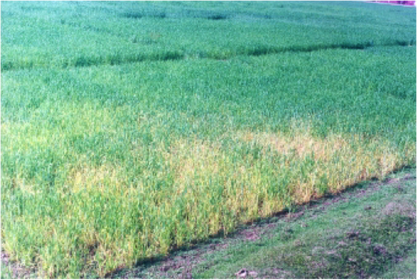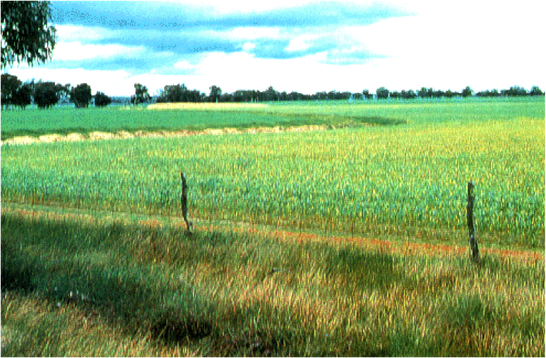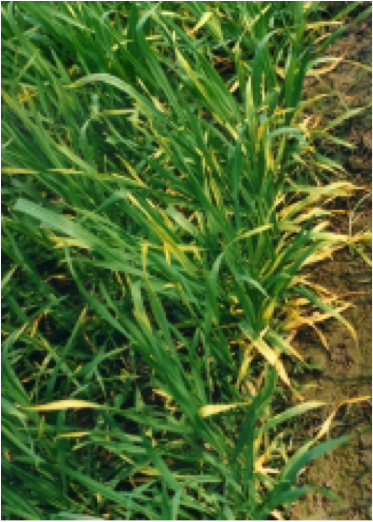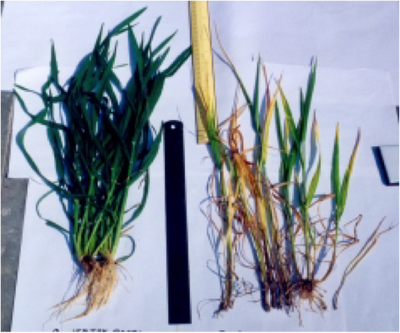After a Long Drought
Waterlogging occurs when rainfall or irrigation water collects on the soil surface for prolonged periods without infiltrating the soil. Soil characteristics that contribute to waterlogging include soil physical properties that allow formation of a crust on the soil surface or of a pan in the subsoil. Waterlogging can also occur when the amount of water added through rainfall or irrigation is more than what can percolate into the soil within one or two days.
Waterlogging occurs when rainfall or irrigation water collects on the soil surface for prolonged periods without infiltrating the soil. Soil characteristics that contribute to waterlogging include soil physical properties that allow formation of a crust on the soil surface or of a pan in the subsoil. Waterlogging can also occur when the amount of water added through rainfall or irrigation is more than what can percolate into the soil within one or two days.
Conditions and Symptoms Associated with Waterlogging
Except at sowing or during early germination, waterlogging will not generally destroy wheat or small grain plants nor affect plant establishment. The morphological and biochemical effects are manifold, but under mild waterlogging wheat plant growth is usually stunted, bottom leaves senesce, tiller survival is reduced, and florets may become sterile.
High temperatures tend to exacerbate the negative effects of waterlogging. When aerobic soil conditions re-occur, plant growth resumes slowly. Consequently, wheat yields are affected. An entire field will rarely be waterlogged; waterlogging is usually restricted to the lower lying areas of a field (Picture 1). Waterlogging occurs when the soil is fully saturated, and standing water replaces the air in the soil pore spaces. There is a lack of oxygen in the soil, restricting aerobic respiration by growing roots and other living organisms. Soil chemical properties change when anaerobic conditions persist for several days, increasing the availability of some major or minor elements while decreasing the availability of others. Plant transpiration is affected until wheat roots recover (when soil aerobic conditions recur) or adapt to the anaerobic conditions. However, extended waterlogging will result in root death. Waterlogging also limits the wheat plant’s nutrient uptake by reducing plant transpiration and diminishing root function.
Except at sowing or during early germination, waterlogging will not generally destroy wheat or small grain plants nor affect plant establishment. The morphological and biochemical effects are manifold, but under mild waterlogging wheat plant growth is usually stunted, bottom leaves senesce, tiller survival is reduced, and florets may become sterile.
High temperatures tend to exacerbate the negative effects of waterlogging. When aerobic soil conditions re-occur, plant growth resumes slowly. Consequently, wheat yields are affected. An entire field will rarely be waterlogged; waterlogging is usually restricted to the lower lying areas of a field (Picture 1). Waterlogging occurs when the soil is fully saturated, and standing water replaces the air in the soil pore spaces. There is a lack of oxygen in the soil, restricting aerobic respiration by growing roots and other living organisms. Soil chemical properties change when anaerobic conditions persist for several days, increasing the availability of some major or minor elements while decreasing the availability of others. Plant transpiration is affected until wheat roots recover (when soil aerobic conditions recur) or adapt to the anaerobic conditions. However, extended waterlogging will result in root death. Waterlogging also limits the wheat plant’s nutrient uptake by reducing plant transpiration and diminishing root function.
Another effect of waterlogging is to stimulate the production of certain plant hormones. In anaerobic conditions these hormones are released from the roots in greater concentrations and may affect leaf and root responses. Ethylene is produced both by the roots and by microorganisms in waterlogged soils. The hormonal effects of ethylene released under waterlogging are attracting a great deal of interest. Water acts as a barrier to the escape of ethylene produced in roots and other submerged tissue. Ethylene is known to be a trigger (not a promoter) of leaf senescence.
Waterlogging during sowing or germination generally kills the seed or seedling. The seedling’s radicle and roots do not adapt readily to waterlogging or are more susceptible to seedling diseases that may follow. Generally, the wheat plant’s tolerance to waterlogging increases as it ages, and the detrimental effect on yield decreases. Once the wheat crop is established, many genotypes can withstand waterlogging up to 10 days with no yield loss, if the wheat leaves are not submerged. Wheat crops can make an amazing recovery following early waterlogging stress, if supplied with extra nitrogen.
In waterlogged soils and in the roots of plants growing in them, exceptionally high levels of ethylene may build up, given that ethylene diffuses more slowly in water than in aerated soil. The first response of a wheat plant to anaerobic conditions involves its biochemical pathways as a response to the lack of respiration by root cells. Various hormones are stimulated and transported to the leaves, causing early senescence of older leaves within days. Seminal roots are generally killed or their growth greatly restricted.
Effect of Waterlogging on Soil Chemistry
Decreases in yield brought about by waterlogging may be caused by numerous factors acting upon the wheat plants, such as changes in soil chemistry. As an example, denitrification of soil nitrogen as a result of waterlogging may affect the amount of nitrogen that concentrates and accumulates in the upper leaves of the plants, which will eventually have a negative effect on grain yield. Table 1 shows a list of soil chemical responses and the corresponding bibliographic references that can be consulted for further information on each.
Genetic Improvement of Waterlogging Tolerance
Some studies have suggested that the waterlogging tolerance trait is highly heritable, others demonstrated there is little variability for waterlogging tolerance among durum wheat lines.
Screening techniques in the laboratory or the field are well documented in the literature. While waterlogging tolerance is directly related to the ability to quickly form roots with aerenchyma cells under anaerobic conditions, there may be concurrent tolerance to Mn toxicity (Wagatsuma et al., 1990). Tolerance to Mn toxicity seems to be secondary to the formation of aerenchyma cell in roots for extending tolerance.
Waterlogging during sowing or germination generally kills the seed or seedling. The seedling’s radicle and roots do not adapt readily to waterlogging or are more susceptible to seedling diseases that may follow. Generally, the wheat plant’s tolerance to waterlogging increases as it ages, and the detrimental effect on yield decreases. Once the wheat crop is established, many genotypes can withstand waterlogging up to 10 days with no yield loss, if the wheat leaves are not submerged. Wheat crops can make an amazing recovery following early waterlogging stress, if supplied with extra nitrogen.
In waterlogged soils and in the roots of plants growing in them, exceptionally high levels of ethylene may build up, given that ethylene diffuses more slowly in water than in aerated soil. The first response of a wheat plant to anaerobic conditions involves its biochemical pathways as a response to the lack of respiration by root cells. Various hormones are stimulated and transported to the leaves, causing early senescence of older leaves within days. Seminal roots are generally killed or their growth greatly restricted.
Effect of Waterlogging on Soil Chemistry
Decreases in yield brought about by waterlogging may be caused by numerous factors acting upon the wheat plants, such as changes in soil chemistry. As an example, denitrification of soil nitrogen as a result of waterlogging may affect the amount of nitrogen that concentrates and accumulates in the upper leaves of the plants, which will eventually have a negative effect on grain yield. Table 1 shows a list of soil chemical responses and the corresponding bibliographic references that can be consulted for further information on each.
Genetic Improvement of Waterlogging Tolerance
Some studies have suggested that the waterlogging tolerance trait is highly heritable, others demonstrated there is little variability for waterlogging tolerance among durum wheat lines.
Screening techniques in the laboratory or the field are well documented in the literature. While waterlogging tolerance is directly related to the ability to quickly form roots with aerenchyma cells under anaerobic conditions, there may be concurrent tolerance to Mn toxicity (Wagatsuma et al., 1990). Tolerance to Mn toxicity seems to be secondary to the formation of aerenchyma cell in roots for extending tolerance.
Table 1. Soil chemical responses to waterlogging as reported in the literature.
| Chemical response | Reference |
|---|---|
| Increased Mn concentration that could be toxic to plant growth | Sparrow and Uren, 1987; Wagatsuma et al., 1990 |
| Decreased soil oxygen; generally greater at warmer temperatures | Belford et al., 1985 |
| Decreased Mo availability; Mo application in waterlogged, acid soils retained plastid pigments, cyclic phosphorylation, and CO2 fixation within wheat plants | Salcheva et al., 1984 |
| Denitrification of both organic and inorganic soil N | Feigenbaum et al., 1984; Singh et al., 1988; Mascagni and Sabbe, 1991; Humphrey et al., 1991 |
| Mineral (Fe) coating of epidermal surface of roots under waterlogging | Ding and Musgrave, 1995 |
| Volatile fatty acids and phenolic compounds accumulated in soils high in organic matter affect root metabolism and growth | Lynch, 1978; Jackson and St. John, 1980 |
Drainage of flat, clayey soils
Waterlogging and inundation are also common on flat, clayey soils. If the water is running off from higher up in the catchment, divert it using W drains or levees. If the water comes from seepage in nearby duplex soils, then drain the soils with seepage interceptors. Make sure that the drains empty into a well-defined waterway.
Poor soil structure often prevents the rain soaking into the soil or the land is too flat for adequate runoff. These factors could cause waterlogging.
Applying gypsum can improve the soil structure. Gypsum improves soil stability and applied gypsum can also reduce the amount of tillage in the cropping phase. Preventing stock from pugging the area in winter is important.
In areas with poor surface drainage, a slope can be created towards drain channels using 'beds' or 'lands' formed from soil taken out of the channels. The channels are aligned in the direction of maximum fall. The beds are made using a grader, disk plough or mouldboard to remove the soil from the channel and place it in a raised bed between the channels. The width of the cropping machinery to be used determines the distance between the channels.
Choice of crop
Grain legumes and canola are generally more susceptible to waterlogging than cereals and faba beans.
Table 2. Susceptibility of major crops to waterlogging
| Most tolerant | Most susceptible |
|---|---|
| Faba beans | Lentils |
| Oats | |
| Wheat | |
| Barley* | |
| Canola | |
| Lupins | |
| Peas | |
| Chickpeas |
* Barley tolerates salt better than wheat in the absence of waterlogging, but is more sensitive to waterlogging in both slaine and unsaline conditions.
Little is known about the relative tolerance to waterlogging of different varieties of each of the crops. Franklin barley, however, is more susceptible to prolonged waterlogging than Onslow barley, which is similar to wheat.
With lupin species (See below), the commonly grown narrow-leafed lupin (Lupinus angustifolius) is susceptible and the yellow lupin (Lupinus luteus) is the most tolerant to waterlogging. Few field data are available for the range of species under development.
Probable susceptibility of lupin species to waterlogging
Most tolerant:
Seeding
Sowing crops early and using long-season varieties help to avoid crop damage from waterlogging. Damage to crops is particularly severe if plants are waterlogged between germination and emergence. Plant first those paddocks that are susceptible to waterlogging. However, if waterlogging delays emergence and reduces cereal plant density to fewer than 50 plants/m2, resow the crop.
Increase seeding rates in areas susceptible to waterlogging to give some insurance against uneven germination, and to reduce the dependence of cereal crops on tillering to produce grain. Waterlogging depresses tillering. High seeding rates will also increase the competitiveness of the crop against weeds, which take advantage of stressed crops.
Fertiliser
The crop will tolerate waterlogging better if it has a high nitrogen status before it becomes waterlogged. Applications of nitrogen at the end of a waterlogging period can be an advantage if nitrogen that was applied at or shortly after seeding has been lost by leaching or denitrification. However, nitrogen cannot usually be applied from vehicles when soils are wet, so aerial applications may be worth considering.
Ammonium is less likely to leach than nitrate so ammonium forms of nitrogen (UAN, DAP) are preferable to nitrate forms (UAN, which contains nitrate, ammonium and urea). However, ammonium forms of nitrogen may increase soil acidity.
Farm planning
Drainage to remove as much excess water as possible will minimise waterlogging, weeds, nutrient deficiency and disease. In extreme cases, drains may allow land use to change from poor pasture to productive cropping (Picture 2).
With lupin species (See below), the commonly grown narrow-leafed lupin (Lupinus angustifolius) is susceptible and the yellow lupin (Lupinus luteus) is the most tolerant to waterlogging. Few field data are available for the range of species under development.
Probable susceptibility of lupin species to waterlogging
Most tolerant:
- Lupinus luteus,
- Lupinus angustifolius (for example, Gungurru),
- Lupinus atlanticus,
- Lupinus pilosus
Seeding
Sowing crops early and using long-season varieties help to avoid crop damage from waterlogging. Damage to crops is particularly severe if plants are waterlogged between germination and emergence. Plant first those paddocks that are susceptible to waterlogging. However, if waterlogging delays emergence and reduces cereal plant density to fewer than 50 plants/m2, resow the crop.
Increase seeding rates in areas susceptible to waterlogging to give some insurance against uneven germination, and to reduce the dependence of cereal crops on tillering to produce grain. Waterlogging depresses tillering. High seeding rates will also increase the competitiveness of the crop against weeds, which take advantage of stressed crops.
Fertiliser
The crop will tolerate waterlogging better if it has a high nitrogen status before it becomes waterlogged. Applications of nitrogen at the end of a waterlogging period can be an advantage if nitrogen that was applied at or shortly after seeding has been lost by leaching or denitrification. However, nitrogen cannot usually be applied from vehicles when soils are wet, so aerial applications may be worth considering.
Ammonium is less likely to leach than nitrate so ammonium forms of nitrogen (UAN, DAP) are preferable to nitrate forms (UAN, which contains nitrate, ammonium and urea). However, ammonium forms of nitrogen may increase soil acidity.
Farm planning
Drainage to remove as much excess water as possible will minimise waterlogging, weeds, nutrient deficiency and disease. In extreme cases, drains may allow land use to change from poor pasture to productive cropping (Picture 2).
Drains also reduce the variability in yields within a paddock. However, separating those areas that are most susceptible to waterlogging and inundation may be necessary (if they are large enough) as fertilising and spraying areas that cannot benefit from the applications is wasteful.
Weed control
The number of weeds in the crop affects its ability to recover from waterlogging. The weeds compete for water and the small amount of remaining nitrogen, hence the waterlogged parts of a paddock are often weedy. If herbicide resistance is not a problem, spray the weedy areas with a post-emergent herbicide when the paddock is dry enough to allow access, provided the crop is at an appropriate growth stage.
Aerial spraying is an alternative when ground-based sprays cannot be used.
Disease control
Root diseases, particularly take-all of and barley, are often more severe in waterlogged crops because the pathogens tolerate waterlogging and low oxygen levels better than the crops. Eliminating grasses from the preceding crops or pastures will reduce the severity of take-all in both well-drained and waterlogged areas. Leaf diseases are likely to be more severe in waterlogged crops because the crop is already under stress. Spraying may be an option after the site has dried, but only in crops with a high yield potential.
Specific Physiological Responses of Wheat to Waterlogging as Reported in the Literature:
Weed control
The number of weeds in the crop affects its ability to recover from waterlogging. The weeds compete for water and the small amount of remaining nitrogen, hence the waterlogged parts of a paddock are often weedy. If herbicide resistance is not a problem, spray the weedy areas with a post-emergent herbicide when the paddock is dry enough to allow access, provided the crop is at an appropriate growth stage.
Aerial spraying is an alternative when ground-based sprays cannot be used.
Disease control
Root diseases, particularly take-all of and barley, are often more severe in waterlogged crops because the pathogens tolerate waterlogging and low oxygen levels better than the crops. Eliminating grasses from the preceding crops or pastures will reduce the severity of take-all in both well-drained and waterlogged areas. Leaf diseases are likely to be more severe in waterlogged crops because the crop is already under stress. Spraying may be an option after the site has dried, but only in crops with a high yield potential.
Specific Physiological Responses of Wheat to Waterlogging as Reported in the Literature:
- Chlorosis of lower leaves (Picture 3).
- Early senescence of lower leaves.
- Decreased plant height.
- Delayed ear emergence.
- Reduced root and shoot growth.
- Lower number of spike-bearing tillers (Picture 4).
- Fewer grains per spikelet and reduced kernel weight.
- Reduced diameter of metaxylem and protoxylem vessels of the nodal roots.
- Enhanced formation of aerenchyma cells in the cortical tissue of both seminal and nodal roots.
- Leakage of cell electrolytes.
- Reduced uptake of N, P, K, Ca, Mg, and Zn while increasing Na, Fe, and Mn absorption under alkaline soil conditions.
- Reduced root respiration
- In wheat oxygen concentrations between 33 and 66 μg m2 s-1 were categorized as deficient and < 33 μg m2 s-1 as critical. Roots were significantly reduced by the small amount of oxygen available, especially at lower depths. Temperature also influenced root reduction, with 15oC appearing to be the best soil temperature for root growth.
- Decreases in wheat yields of 37-45% due to waterlogging have been observed. Wheat yield depression was due to reduced kernel number and weight rather than to an effect on stand establishment.
- Waterlogging was shown in one study to cause only slight suppression of flag-leaf photosynthesis and leaf conductance in waterlogging intolerant wheat lines. Other studies showed overall lowered rates of plant photosynthesis, stomatal conductance, and transpiration.
- Root carbohydrate supply was shown in some studies not to be a limiting factor for root growth and respiration.
- Anoxia (waterlogging) inhibited the transport of sugars from the shoots to the roots by more than 79% in seedlings. However, there are interactions between temperature and other environmental factors that could affect interpretation of data on tolerance of wheat to anoxia, which explains the lack of consistent results in the literature.
- Data collected on wheat under waterlogged conditions (i.e., deficient in oxygen) in the field and glasshouse showed that the biosynthesis of new tissue was more inhibited than the supply of substrates for growth.
- Flower sterility associated with waterlogging is linked to lower transpiration and, hence, to less uptake of boron (and other nutrients).
- Ethylene production increases and acts as a trigger (not promoter) of accelerated wheat plant senescence. Exogenous cytokinins applied to wheat seedlings at the onset of waterlogging delayed degradation of chlorophyll and other biochemical processes. Enhancement of ACC (1-aminocyclopropane-1-carboxylic acid), its precursor, and ethylene was more pronounced in older leaves than in younger ones during waterlogging.
- Less nitrogen concentrates and accumulates in the upper leaves of waterlogged wheat, probably due to the denitrification of soil nitrogen
- Nitrogen remobilization from lower leaves is accelerated on flooded soils and explains their chlorosis
- Reduced rooting depth and increased root porosity




